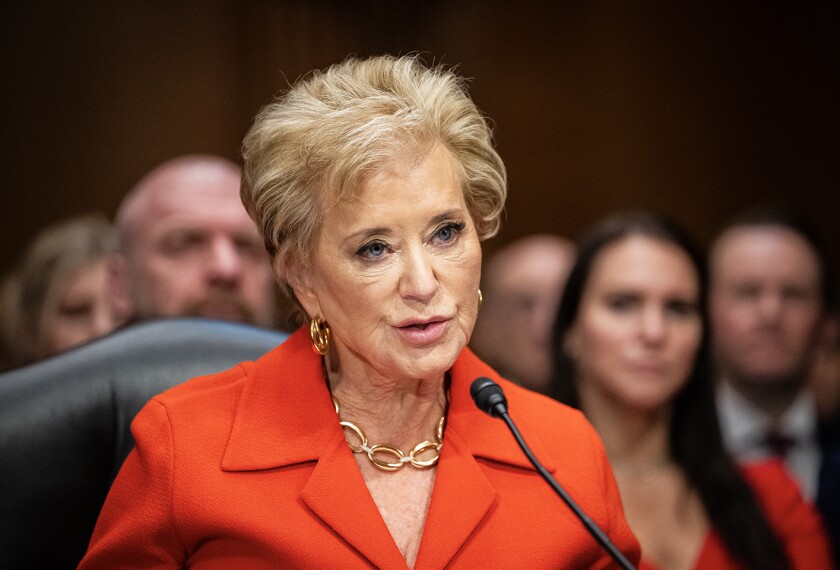A bipartisan group of senators introduced a plan last week to turn around U.S. high schools with the worst dropout problems.
In the most comprehensive congressional proposal addressing high school improvement introduced this year, five members of the Senate education committee are sponsoring a bill that would authorize $2.4 billion a year to provide grants to high schools with the highest dropout rates and support proven methods to increase their graduation rates and help middle schools identify students at risk of not completing high school.
Half of the nation’s dropouts attend 15 percent of its high schools, one researcher told the Senate education committee, pointing out that the problem can be addressed with a targeted grant program reaching about 2,000 schools.
“These high schools are unfortunately the nation’s dropout factories,” Robert Balfanz, an associate research scientist at the Center for Social Organization of Schools at Johns Hopkins University in Baltimore, told the Senate Health, Education, Labor, and Pensions Committee at a hearing on April 24.
With a small percentage of schools contributing to half the problem, Congress won’t need to take dramatic action to find a solution, said Sen. Edward M. Kennedy, D-Mass., the chairman of the education committee and one of the bill’s co-sponsors.
“It suggests to me that this possibly is a manageable problem,” Sen. Kennedy said.
Sen. Jeff Bingaman, D-N.M., introduced the Graduation Promise Act on April 23. In addition to Mr. Kennedy, the co-sponsors are Sen. Richard M. Burr, R-N.C.; Sen. Hillary Rodham Clinton, D-N.Y.; and Sen. Patty Murray, D-Wash. All the backers are members of the education committee.
“We are at a point where there is a critical mass of concern about this dropout problem,” Mr. Bingaman said at the April 24 hearing. “We now know enough to do something significant.”
He said he hopes the bill will eventually be incorporated into the reauthorization of the No Child Left Behind Act, which includes the Title I program for disadvantaged students and other K-12 programs.
The $12.7 billion Title I program allocates 92 percent of its money to elementary schools, Mr. Bingaman said, leaving little funding to improve middle and high schools.
High school reform is shaping up as a significant issue for Congress as it considers the reauthorization of the 5-year-old NCLB law this year.
In its reauthorization blueprint, the Bush administration proposes that high schools add two years of testing to measure whether students are prepared for college or the workforce. It also would allocate 90 percent of Title I spending increases to high schools. (“Bush Plan Would Heighten NCLB Focus on High School,” Feb. 7, 2007.)
The Graduation Promise Act is one of several bills that Sen. Kennedy backs in an attempt to outline his priorities for the second generation of the NCLB law, one of his aides said last week. Mr. Kennedy would be willing to incorporate other members’ proposals on high schools when drafting the larger NCLB reauthorization proposal he brings before the committee, the aide said.
The staff of the Senate education panel is drafting an NCLB bill that it expects to present to the committee for a vote by summer.
Addressing the Problem
Under the Graduation Promise Act, states would receive grants to address the needs of their lowest-performing high schools. Those schools would be identified by low levels of advanced coursetaking, poor performance on state tests, low attendance rates, and other measures that researchers link to high dropout rates. The states would produce plans to change those schools, choosing options ranging from target interventions to school overhauls.
States also would need to come up with plans to identify middle schools where students showed the early signs that they were likely to drop out, such as high failure rates in academic courses and low attendance rates.
Mr. Balfanz, who is one of the leading researchers on high school dropout rates, told the Senate committee last week that the key feature of the bill is the way it would target the schools that have the lowest graduation rates. Although mostly in impoverished areas, those schools are spread across the country.
The widespread nature of the problem will help win support for the bill, Sen. Kennedy said after Mr. Balfanz’s testimony.
“It’s interesting that it’s North, South, East, and West,” Sen. Kennedy said. “That’s the basis you have around here for a coalition to do something.”




